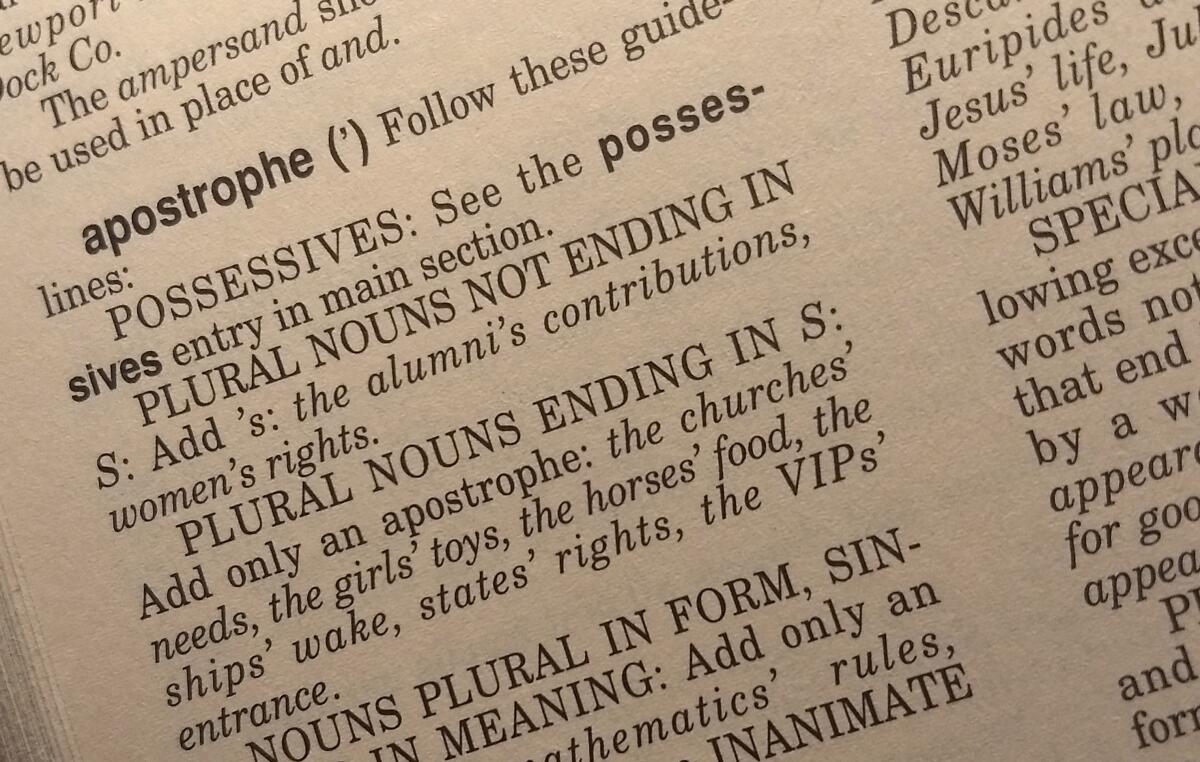A Word, Please: When to use an apostrophe to form a plural, even though it seems wrong

- Share via
When it comes to apostrophes, there are a lot of do’s and don’ts. The least-understood and most crucial of all is: Don’t use an apostrophe to form a plural. One luau plus another luau is not two luau’s. It’s two luaus. One Roddenberry plus another Roddenberry do not make up the Roddenberry’s. They’re the Roddenberrys.
The same is true for decades. The period from 1980 to 1989 is not the 1980’s. It’s the 1980s. You can use an apostrophe to stand in for the dropped 1 and 9: ’80s. But it’s still wrong to write 80’s.
Simple, right? If you read fast through the first sentence of this column, it can seem that way. But if you did a double-take on “do’s and don’ts,” you know that apostrophe rules are anything but simple.
“Do’s” defies the rule because it uses an apostrophe to make a plural out of “do.” Plus, this expression contains its own double-standard: It uses an apostrophe to make “do’s” plural, but it does not add an apostrophe to make “don’ts” plural.
Makes no sense. If we’re following the rules, it should be “dos and don’ts.” If we’re going to defy the rules, we would have to make it “do’s and don’t’s,” with two apostrophes in “don’t’s,” for consistency’s sake, right?
Yes. If logic reigned supreme, we couldn’t possibly use one rule for do’s then another for don’ts. Yet I do. Why? Because this column conforms to Associated Press editing style, and in AP Style, that’s the rule: do’s and don’ts. Someone at AP decided years ago that this way is just easier on the eye. Publications that follow this style — that is, most print news outlets in the country — comply.
There’s a lot more to bad writing than missed commas and subject-verb agreement errors. Here are some specific examples.
AP isn’t the only sheriff in town. The Chicago Manual of Style, which book and magazine publishers tend to follow, disagrees. In Chicago style, it’s “dos and don’ts.” No extra apostrophe.
On other apostrophe matters, the stylebooks agree. For example: Dot your i’s and cross your t’s. Both AP and Chicago agree that you can toss out the no-apostrophes-for-plurals rule here. You can see why. Without an apostrophe, I plus S spells a word: is. The apostrophe is the only way to make clear you’re talking about the letter.
Both style guides agree that when you’re talking about a lowercase letter, you add an apostrophe to make it plural: x’s and y’s. It’s the only way to make your meaning clear.
Capital letters are another matter. AP says to use apostrophes to make them plural: She got all A’s, B’s and C’s.
The Chicago Manual is a little fuzzier on this matter, but you can use those apostrophes in Chicago style, too, if you think they help the reader understand you don’t mean the word “as” or the abbreviation BS.
In AP, multiple-letter combos like ABC and IOU don’t get the same treatment as single letters like A and B. To make the combos plural, don’t use an apostrophe: ABCs, IOUs.
You don’t have to memorize all these rules. No one will think you’re dumb for choosing “dos and don’ts” or “do’s and don’ts.” Your reader probably doesn’t know the rules either. Nor will your reader judge you for how you write letter grades. If you write that Bobby got B’s and C’s on his report card, you’ll be no worse off than if you write it Bs and Cs.
If you don’t want to worry about complicated rules and competing styles, this simple guideline should get you through most situations: Never use an apostrophe to form a plural unless you think it will help your reader.
June Casagrande is the author of “The Joy of Syntax: A Simple Guide to All the Grammar You Know You Should Know.” She can be reached at [email protected].
All the latest on Orange County from Orange County.
Get our free TimesOC newsletter.
You may occasionally receive promotional content from the Daily Pilot.




